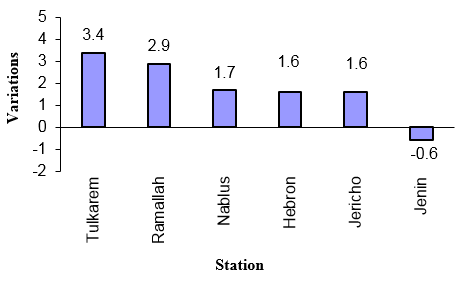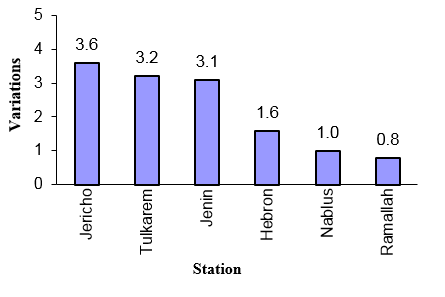Press Release by Palestinian Central Bureau of Statistics (PCBS) and the Palestinian Meteorological Directorate (PMD) on the Occasion of World Meteorological Day (WMD), March 23, 2016.
This Year’s Theme: "Hotter, Drier, Wetter - Face the Future"
Every year on 23 March, the World Meteorological Organization (WMO), which has 189 members, and the global meteorological community celebrate the World Meteorological Day around a chosen theme. This year’s theme is “Hotter, Drier, Wetter - Face the Future”
In Palestine, this day is celebrated by Meteorological bodies, mainly (PMD).
The PMD conducts optimal observation of climatic conditions in the direct or indirect service of different forms of life to contribute effectively to the development of the national economy. Palestine is an observer in the WMO and a member of the Arab Organization of Meteorology in the League of Arab States.
Meteorological statistics form a crucial part of the environmental statistics collected by PCBS from administrative records.
Higher Average Rainfall in 2015
The amount of rainfall in 2015 was higher than the mean average in most of the stations, scoring a total amount of 667 mm in Tulkarem Station, and 201 mm in Jericho station. The mean average rainfall in Tulkarem station is 602 mm and 166 mm in Jericho, and the distribution of rainfall level was concentrated in most of the governorates in January and February during the year 2015.
Amount of Rainfall during (1/1-31/12/2015),
and Mean Average Figures in Some West Bank Stations
|
Station |
Quantity of Rainfall (mm) (1/1-31/12/2015) |
From Mean Average% |
|
Tulkarem |
667 |
111 |
|
Ramallah |
612 |
100 |
|
Nablus |
595 |
90 |
|
Hebron |
544 |
91 |
|
Jenin |
529 |
113 |
|
Bethlehem |
512 |
99 |
|
Jericho |
201 |
121 |
Generally, the 2015 year in Palestine was rainy year, just like the rest of the world.
High Temperatures in 2015 Compared with Mean Average
Maximum air temperatures during 2015 were higher than the mean average by )3.4°C( in Tulkarem station; the smallest variation was )- 0.6°C( in Jenin station.
Variations in Maximum Air Temperature in 2015 (°C) From Mean Average in Some West Bank Stations

Minimum temperatures in 2015 were also higher than the mean average by around 0.8 °C in Ramallah station and 3.6 °C in Jericho station.
Variations in Minimum Air Temperature (°C) from Mean Average in Some
West Bank Stations, 2015
 |
Generally, the year 2015 was a hotter year in Palestine and the rest of the world and this concords with the theme of this year.
Higher Total Evaporation in 2015
The total evaporation in 2015 was higher than the mean average in most of the stations. Total Evaporation ranged between 2,338 mm in Jericho station and 1,717 mm in Hebron Station during 2015.
Total Evaporation in 2015 and Mean Average in Some West Bank Stations
|
Station |
Total Evaporation (MM) |
Mean Average |
From Mean Average % |
|
Jericho |
2,338 |
2,101 |
111 |
|
Jenin |
2,045 |
.. |
.. |
|
Nablus |
1,826 |
1,682 |
109 |
|
Ramallah |
1,753 |
1,889 |
93 |
|
Hebron |
1,717 |
1,608 |
107 |
|
..: Data not Available |
|||
While the year 2015 was a rainy year, evaporation amounts witnessed an increase during the same year because of the rise in the temperatures (minimum and maximum), so it can relatively be said that 2015 was a dry year).
Highest Annual Humidity in Nablus, Lowest in Jericho
Data showed that annual relative humidity in 2015 ranged between 45% in Jericho station and 75% in Nablus station.
Mean Relative Humidity (%) in 2015 and Mean Average in Some West Bank Stations
|
Station |
Relative Humidity (%), 2015 |
Mean Average |
From Mean Average % |
|
Nablus |
75 |
61 |
123 |
|
Ramallah |
68 |
57 |
119 |
|
Hebron |
66 |
62 |
106 |
|
Jenin |
66 |
69 |
96 |
|
Tulkarem |
60 |
.. |
.. |
|
Bethlehem |
57 |
.. |
.. |
|
Jericho |
45 |
52 |
87 |
|
..: Data not Available |
|||
Lower Average Hours of Sunlight Compared with 2014
During 2015, the average hours of sunlight ranged between 8.6 hours per day in Jericho station and 8.4 hours per day in Hebron and Jenin station, compared to 2014 figures of 8.9 hours per day in Ramallah station and 8.3 hours per day in Hebron station.
Face the Future…
Data show that Palestine faced and is still going to face the effects of climate change, which are the increasing of temperatures, and evaporation beside the fluctuation of rainfall.
For these reasons Palestine is cooperating with the international community to face the climate change effects. It has joined the United Nations Framework Convention on Climate Change, and committed itself to realizing the objectives of the Convention, most importantly to mitigate emissions released into the air, in addition to the preparation of national communication report on climate change, which has a national plans to adapt to climate change. These plans will consist of commitments by Member States to demonstrate their commitment to dealing with climate change and its consequences.
Palestine is currently preparing its first national communication on climate change.
 عربي
عربي